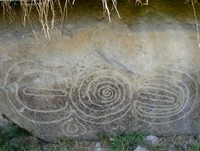|
Ulster, the northernmost
province of Ireland, includes
the six counties of Northern
Ireland and three from the
Republic. It also includes,
an isolated Gaeltacht area
which is home to the
Tory Island Primitive School
of Art. Top Ulster-born
artists include John Butler
Yeats, Gerard Dillon, and
Dan O'Neill. For more, see:
Visual Arts in Ulster.
QUESTIONS
• What key factors influenced the
history of Irish art?
• How were illuminated manuscripts
made in the Christian monasteries?
• What is the Lebor Gabala Erenn?
• How did the different genres like
landscape, genre-painting and
portraiture, evolve in Ireland?
• Who were the best artists during
the 19th century?
• How did Irish Painting develop
during the 20th Century?
• How did Impressionist painting
develop in Ireland?
• Who pioneered Cubism in Ireland?
• How did modern sculpture develop
in Ireland?
• Who are the best contemporary
painters and sculptors?
• Which organizations have the
most impact on Irish art?
• Which are the best art museums
and galleries in Dublin?
• Which are the best art colleges
in Ireland?
• Who is the greatest Irish painter?
• Which are the most expensive Irish paintings ever?
For answers to these and other
popular queries concerning
arts & crafts in Ireland, see:
Irish Art Questions.
|
Monastic
Irish art contributed to the history of Western art in several ways.
First, Irish monasteries taught artist-monks drawing, painting, illustration,
illumination and calligraphy. Second, they sponsored a huge range of metal
artifacts from metalworkers and metallurgical artists, ranging from adornments
for biblical manuscripts to ecclesiastical vessels and accessories. Many
involved the development and strengthening of techniques such as riveting,
soldering, lost-wax casting, cloisonné
enamelling and filigree gold-work. Third, they commissioned a large
number of Celtic
High Cross sculptures on sites throughout Ireland. These biblical
works were created mostly during the period (c.750-1150), and are the
largest body of free-standing sculpture constructed in the thousand years
between the collapse of Rome (c.400) and the Early Renaissance (c.1400).
Indeed, by keeping alive the flame of classical European culture during
this time, Ireland - along with Byzantine culture and that of the Carolingian
and Ottonian courts - helped to pave the way for the seminal accomplishments
of the Florentine Renaissance of the fifteenth century.
Painting
We also cover Irish fine arts created during
the modern era (c.1700-2000). As far as Irish
painting is concerned, we explore all the genres, except still life,
and provide biographical details on ALL famous
Irish artists. In addition, see our personal summary of the Best
Irish Artists (Painters) still living.
Portraiture
We profile Irish
portrait artists (c.1680-2000), including: Garret Morphy (fl.1680-1716),
Charles Jervas (1675-1739), the Tipperary-born James Latham (1696-1747),
Sir Martin Archer Shee (1769-1850), William Mulready (1786-1863), Sarah
Purser (1848-1943), Roderic O'Conor (1861-1940), John Butler Yeats (1839-1922),
Sarah Cecilia Harrison, the genius William Orpen (1878-1931), James
Sinton Sleator (1889-1950), Leo Whelan (1892-1956), Maurice Macgonigal
(1900-1979), the surreal expressionist Francis Bacon (1909-92),
Louis le Brocquy (1916-2012), Edward McGuire (1932-1986), David
Nolan (b.1966), and others.
Landscapes
We also have biographies of Irish
landscape artists (c.1720-2000), including: Susanna Drury (fl. 1733-70),
William Ashford (1746-1824), Thomas Roberts (1749-78), James Arthur O'Connor
(1792-1841), William Sadler (1782-1839), Francis Danby (1793-1861), Rose
Maynard Barton (1856-1929), Joseph Malachy Kavanagh (1856-1918), the eminent
John Lavery (1856-1941), Stanhope Forbes (1857-1947), Dermod O'Brien
(1865-1945), Paul Henry (1876-1958), the townscape painter Harry
Kernoff (1900-1974), the abstract artist Tony O'Malley (1913-2003), and
the Impressionists Donald Teskey (b.1956), John Morris (b.1958), Paul
Kelly (b.1968), Henry McGrane (b.1969), and many others.
Genre-Paintings
In addition, we explore the careers of
Irish genre painters (19th/20th
century), including: James Brenan (1837–1907), Walter Frederick
Osborne (1859-1903), Henry Jones Thaddeus (1859-1929), Nathaniel Hill
(1861-1934), the immortal Jack B Yeats (1871-1957), Sean Keating
(1889-1977), Leo Whelan (1892-1956), Gerard Dillon (1916-1971), Colin
Davidson (b.1968), and others.
We also examine the careers of history
painters like James Barry (1741-1806) and Daniel Maclise
(1806-70), and still-life virtuosos such as William Scott (1913-89),
James English (b.1946) and Conor Walton (b.1970).
Styles/Types of Painting
During the 20th century, the arts hierarchy
in Ireland divided into two opposing camps: the academic-style traditionalists
led by Sean Keating, centred on the Royal
Hibernian Academy; and a more 'internationalist', cosmopolitan group
(led by Mainie Jellett) who eventually established the Irish Exhibition
of Living Art. We review Irish
Painting Styles of the 20th Century, and profile the Irish
Exhibition of Living Art.
In addition, we look at the leading Abstract
Artists of Ireland, and explore plein-air painting. Our list
of the Most Expensive Irish
Paintings features some of the country's finest works.
|
